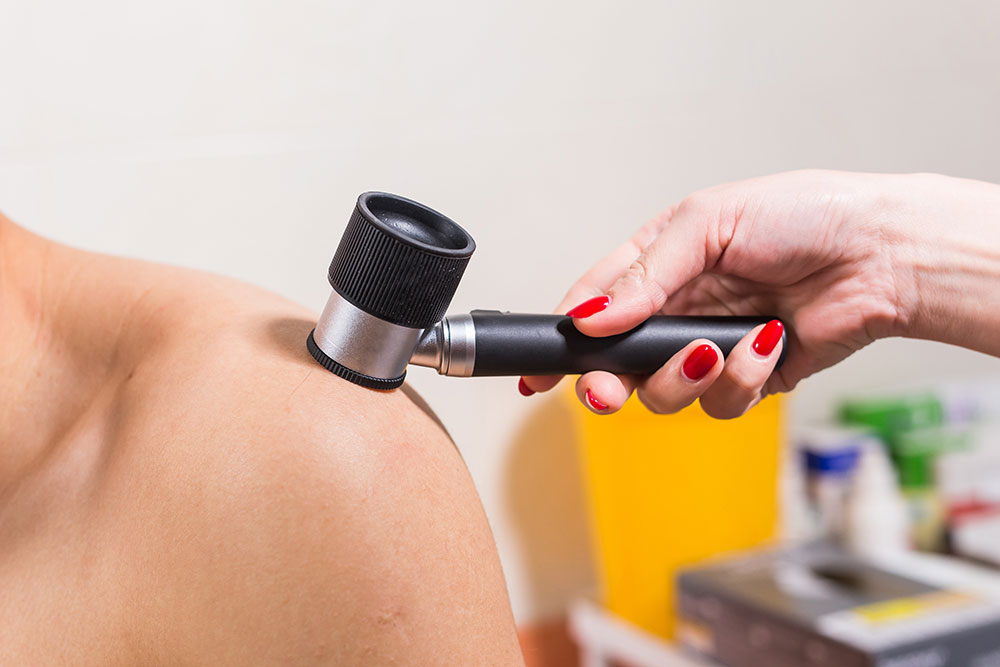در این مقاله ، هر آنچه را که باید در مورد سرطان پوست بدانید دریافت خواهید کرد.
بررسی اجمالی
Skin cancer is a common cancer form that most often appears in the areas of your body exposed to the sun. However, you might develop it in other parts of your body too. The three most prevalent types are basal cell carcinoma, squamous cell carcinoma, and melanoma. Generally, limiting your exposure to the sun or taking precautions can lower your risk of developing this type of cancer. Ultraviolet (UV) radiation is responsible for the malignant transformation of healthy skin cells. Detecting early leads to a better outcome of the disease. This article will focus on the main aspects of skin cancer, such as its prevalence, risk factors, symptoms, diagnosis, and treatment.
How Common Is Skin Cancer?
Skin cancer is the most common cancer in the US. An estimated one in five people will develop the disease once in their lifetime. Also, about 9,500 adults present with skin cancer every year in the US. Generally, non-melanoma skin cancer affects about 3 million adults annually, while currently, 1 million people live with melanoma. It is highly curable if diagnosed early, with a five-year survival rate of 99%.
Risk Factors of Skin Cancer
Risk factors may increase your risk of developing a particular disease. Having many risk factors does not necessarily mean you will have skin cancer. Similarly, not having many does not mean you won’t develop the disease. The following are some of the most well-established risk factors:
- Having fair skin –
Having less pigmented skin increases your chances of developing cancer. The reason is having less melanin, which protects you from UV radiation. - Repetitive sunburns
If you have had repetitive sunburns in childhood, adolescence or adulthood might raise your chance of presenting with skin cancer later in life. - Excessive sun exposure
قرار گرفتن بیش از حد در معرض آفتاب احتمال ابتلا به سرطان پوست را به میزان قابل توجهی افزایش می دهد. اگر از محافظت در برابر اشعه ماوراء بنفش استفاده نکنید ، این خطر حتی بیشتر می شود. - Strong sunlight
Living in sunny places or high altitudes where sunlight is stronger might increase the chance of developing skin cancer. - Skin lesions or moles Having moles or precancerous lesions such as actinic keratoses puts you at high risk.
- History of skin cancer Having a family or a personal history of cancer increases the likelihood of presenting with the disease.
- سیستم ایمنی ناتوان.
Research suggests that having a weak immune system, such as HIV-positive people, raises your chances of having such type of cancer. - Radiation exposure Exposure to radiation or other substances, such as arsenic, considerably increases the risk of skin cancer.
Prevention Of Skin Cancer
Indeed, prevention is always better than cure. Here is what you can do to prevent yourself and family members from developing skin cancer.
- Avoid using indoor tanning beds.
- Use shade to protect the skin when outdoors.
- Wear protective clothing outdoors, like a long-sleeved shirt, pants, UV-protected sunglasses, and a wide-brimmed hat.
- Apply a broad-spectrum and water-resistant sunscreen outdoors.
- Select clothing with a UPF label for extra protection.
- Always protect children from the sun.
Symptoms And Signs of Skin Cancer
Skin cancer usually develops in sun-exposed areas of the body and among all skin tones. Therefore, it might most probably appear in the scalp, ears, face, neck, chest, arms and hands, and legs. However, it can develop in other body parts, such as the palms or genital area, which are not usually sun-exposed. The following are the most common symptoms and signs, according to their type.
Basal Cell Carcinoma
Basal cell carcinoma usually develops in the neck or face, the sun-exposed areas of your body. It would appear as a flat lesion that has the color of your skin or is slightly brownish and looks like a scar. Other times it might resemble a pearly or waxy bump or a sore that bleeds, heals, and recurs again and again.
سرطان سلول سنگفرشی
Squamous cell carcinoma often appears in the face, ears, and hands, the sun-exposed areas of your body. Individuals with darker skin tones might develop it in other body parts. It might look like a flat lesion with a scaly crust or a firm, red nodule.
ملانوم
Melanoma can appear anywhere in the body. It might originate from healthy skin, an existing lesion, or a mole. Women often develop it on the legs while men on the face or trunk. Generally, it might appear in non-sun-exposed areas of the body too. Interestingly, the disease might appear in the palms, soles, or under the fingernails in people with darker skin.
Melanoma might present as a dark spot that might look like a mole and has a speckle pattern. When melanoma manifests in an existing mole, it might change its size, color, or texture. It might also bleed. Melanoma could also appear as a spot with irregular borders. Its color may vary from pink or red to white or bluish. Another presentation could be a lesion that produces discomfort or itchiness. In general, melanoma could appear as new dark lesions in any part of your body, including the mucous membranes.
Detection Of Skin Cancer
Experts recommend you perform a regular self-exam and check for early signs of skin cancer. Self-detected diseases have a higher chance of recovery.
Skin cancer can show warning signs, and you need to keep observing them for their occurrence on your skin. What you need to look for is:
- Change in the shape, size, and color of a skin lesion or mole
- The appearance of a new growth
- A sore that does not heal
- Spots that are different from others \
- Unusual itching, bleeding, or anything changing
When you see these signs, you better not ignore them but make an appointment with a board- certified dermatologist at the earliest.
If there is a family history or you have a higher individual risk factor for skin cancer, it is essential to have regular check-ups.
How Do You Make the Diagnosis of Skin Cancer?
The diagnosis includes two steps:
Inspection of the lesion
First, your doctor will examine your skin and assess whether your lesion could be cancerous.
بیوپسی
Taking some tissue for further examination is necessary to confirm the diagnosis under the microscope. A biopsy will reveal what type of cancer you have.
Imaging tests
این آزمایشات به پزشک کمک می کند تا میزان تومور را بشناسد و اینکه آیا متاستاز دارید یا خیر.
Treatment Of Skin Cancer
After diagnosing and classifying your the disease, your doctor might propose the best therapeutic approach for you. You might need a combination of methods to treat it. Some superficial cancers are entirely removable during the biopsy. However, according to the type of cancer and its extent, you might need further techniques, such as:
- انجماد
- جراحی برش
- جراحی موهس
- کورتاژ و الکترودسیکاسیون یا کرایوتراپی
- درمان فوتودینامیکی
- پرتو درمانی
- درمان بیولوژیکی
- شیمی درمانی
به خاطر داشته باشید که تشخیص زودهنگام به معنی مداخله زودهنگام و پیش آگهی بسیار مطلوب است. در صورت مشاهده هرگونه تغییر در پوست خود ، از جمله خال های تازه تشکیل شده یا لکه هایی که معمولاً ظاهر نمی شوند ، برای بررسی های بیشتر با پزشک خود مشورت کنید.







